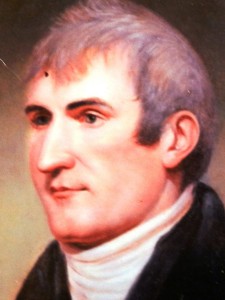‘Helena’ Category
» posted on Tuesday, August 14th, 2012 by Linda Lou Burton
On Watch
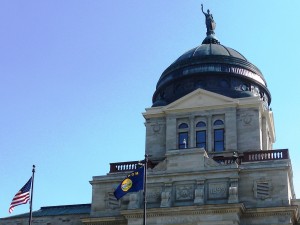 Linda Burton posting from Helena, Montana – The brisk hot wind had the flags at the State Capitol furled out full today, and Montana, the 17-foot statue atop the handsome copper dome, stood watch. From below, it’s hard to see the liberty cap Montana wears but we know it represents freedom. The literature tells us she holds three symbolic items – a shield for the United States, a laurel wreath for victory, and a torch to light the way. Governor Brian Schweitzer introduces the Capitol as the People’s House in the Montana Historical Society publication that is handed out to one and all; he calls it “a readily recognizable icon of democracy.” And the people come; to gather in solidarity or opposition, to speak their mind, to celebrate, or just to see. Washington DC-based Concerned Women for America (CWA) made a bus stop at the Capitol today, urging women of faith to register and vote in the 2012 elections. Inside, a Missoula group called the Blue Skies Campaign continued their week-long sit-in opposing coal development in eastern Montana. At the Visitor’s Desk a couple from Germany inquired about the significance of the Capitol’s copper dome; another couple stopped for directions to “the famous Russell painting.” I headed for the rotunda. » read more
Linda Burton posting from Helena, Montana – The brisk hot wind had the flags at the State Capitol furled out full today, and Montana, the 17-foot statue atop the handsome copper dome, stood watch. From below, it’s hard to see the liberty cap Montana wears but we know it represents freedom. The literature tells us she holds three symbolic items – a shield for the United States, a laurel wreath for victory, and a torch to light the way. Governor Brian Schweitzer introduces the Capitol as the People’s House in the Montana Historical Society publication that is handed out to one and all; he calls it “a readily recognizable icon of democracy.” And the people come; to gather in solidarity or opposition, to speak their mind, to celebrate, or just to see. Washington DC-based Concerned Women for America (CWA) made a bus stop at the Capitol today, urging women of faith to register and vote in the 2012 elections. Inside, a Missoula group called the Blue Skies Campaign continued their week-long sit-in opposing coal development in eastern Montana. At the Visitor’s Desk a couple from Germany inquired about the significance of the Capitol’s copper dome; another couple stopped for directions to “the famous Russell painting.” I headed for the rotunda. » read more
» posted on Monday, August 13th, 2012 by Linda Lou Burton
A Ton of Bricks
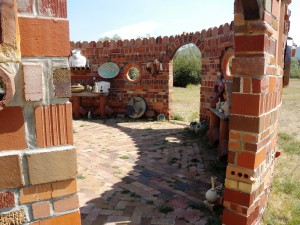 Linda Burton posting from Helena, Montana – If you’re going to lock your keys in your car you couldn’t choose a better place than “The Bray.” I heard about the Archie Bray Foundation for the Ceramic Arts the first day I arrived in Helena. Now (after that door-slam when you instantly realize your keys are still on the car seat) I’m sitting on the steps of their office waiting for AAA to arrive with the unlocking thing-a-majig. I’ve got one eye on the Scion and the other on an interesting circular structure just off to my right. The little brown brochure with a map of the place tells me it’s the Potter’s Shrine, built to reflect construction techniques used in the original buildings and to honor past and present ceramic artists at The Bray. It’s dedicated to Archie Bray, whose vision “gave birth to the Foundation” and it contains a bust of the man, sculpted by Rudy Autio in 1952. I started walking down the gravel drive and saw an array of brick buildings and chimneys and artworks scattered around this site that once was a brick factory, according to the brochure. A brick factory? A Foundation supporting ceramic artists? A man named Archie Bray? How did it all come together? » read more
Linda Burton posting from Helena, Montana – If you’re going to lock your keys in your car you couldn’t choose a better place than “The Bray.” I heard about the Archie Bray Foundation for the Ceramic Arts the first day I arrived in Helena. Now (after that door-slam when you instantly realize your keys are still on the car seat) I’m sitting on the steps of their office waiting for AAA to arrive with the unlocking thing-a-majig. I’ve got one eye on the Scion and the other on an interesting circular structure just off to my right. The little brown brochure with a map of the place tells me it’s the Potter’s Shrine, built to reflect construction techniques used in the original buildings and to honor past and present ceramic artists at The Bray. It’s dedicated to Archie Bray, whose vision “gave birth to the Foundation” and it contains a bust of the man, sculpted by Rudy Autio in 1952. I started walking down the gravel drive and saw an array of brick buildings and chimneys and artworks scattered around this site that once was a brick factory, according to the brochure. A brick factory? A Foundation supporting ceramic artists? A man named Archie Bray? How did it all come together? » read more
» posted on Sunday, August 12th, 2012 by Linda Lou Burton
Now and Then
Linda Burton posting from Helena, Montana – You can’t throw a rock around here without hitting something named Lewis and Clark. Helena is the county seat of Lewis and Clark County; the Lewis and Clark National Forest is all around. It’s no wonder their names are everywhere, because Meriwether Lewis and William Clark had quite an impact on this part of the country. And this part of the country had an impact on them, as we can read in their journals. We have the Missouri River to thank for their visit; one might say that in travel and exploration, mountains are walls and rivers are the roads through them. The Missouri River road brought Lewis and Clark (and Sacajawea) here; between July 16, 1805 and July 24 to be exact; their Journal entries tell us what they saw, what they did, and how they felt about it all. Lewis writes that they killed a buffalo near the river on July 16, and dined on it for breakfast. On the 17th he notes the sunflowers blooming abundantly in the river bottom. The next day he writes of his eagerness to meet up with the Shoshone as he hopes to get information from them. But it’s the entry of July 19 that stirs excitement for me today, as I head for the “gates of the mountains,” to see what Captain Lewis described in his journal. » read more
» posted on Saturday, August 11th, 2012 by Linda Lou Burton
Red Flag Flying
 Linda Burton posting from Helena, Montana – I finally put two and two together this morning. My eyes had been burning like crazy for several days; no amount of eye drops seemed to help. Was I spending too much time staring at the computer screen? I’d had a nagging little night cough too; it seemed to begin when I opened the window for some fresh air as I went to bed. But come to think of it, I hadn’t been able to see the Sleeping Giant mountain for several days; the valley was covered in haze. Maybe the air wasn’t so fresh, after all. On my way to breakfast, I stopped at the front desk and asked. “Yes, there’s a forest fire burning to the north,” she confirmed. “All that smoke in the valley is bad for a person’s allergies.” Allergies, and eyes, I thought. Back in my room, I closed my window and sat down with my coffee to find what I could about forest fires in Montana. The InciWeb Incident Information System at the Montana State Travel Site quickly brought me up to date. http://visitmt.com/fire/conditions.htm » read more
Linda Burton posting from Helena, Montana – I finally put two and two together this morning. My eyes had been burning like crazy for several days; no amount of eye drops seemed to help. Was I spending too much time staring at the computer screen? I’d had a nagging little night cough too; it seemed to begin when I opened the window for some fresh air as I went to bed. But come to think of it, I hadn’t been able to see the Sleeping Giant mountain for several days; the valley was covered in haze. Maybe the air wasn’t so fresh, after all. On my way to breakfast, I stopped at the front desk and asked. “Yes, there’s a forest fire burning to the north,” she confirmed. “All that smoke in the valley is bad for a person’s allergies.” Allergies, and eyes, I thought. Back in my room, I closed my window and sat down with my coffee to find what I could about forest fires in Montana. The InciWeb Incident Information System at the Montana State Travel Site quickly brought me up to date. http://visitmt.com/fire/conditions.htm » read more
» posted on Friday, August 10th, 2012 by Linda Lou Burton
Talent Is
 Linda Burton posting from Helena, Montana – “To have talent is no credit to its owner,” Charlie Russell said in 1925. “What man can’t help he should get neither credit nor blame for.” Charles Marion Russell (1864-1926) moved to Montana when he was sixteen, seeking the life of a cowboy. It wasn’t his talent, however; he was fired from his sheep-ranching job in just a few months. He followed Jake Hoover for a while, hunting and trapping; then hired on as a wrangler at a cattle ranch near Missoula. He was finally living the cowboy life, going on cattle drives; he continued this for seven years. He also spent a year with the Blackfoot Indians, learning their ceremonies, hunting methods, and tribal legends. He sketched and drew these things he experienced during a time of Montana’s vanishing frontier – the 1880’s and 1890’s. And Charlie Russell found his talent. He created more than 4,000 paintings, drawings, and sculptures in his lifetime, becoming one of the world’s best-known and most authentic western artists. Today his statue represents Montana in Statuary Hall in Washington, DC. As I read the story of this remarkable man, I see two significant marking points – in 1886 and in 1896 – when the talent he was so modest about began to be recognized. » read more
Linda Burton posting from Helena, Montana – “To have talent is no credit to its owner,” Charlie Russell said in 1925. “What man can’t help he should get neither credit nor blame for.” Charles Marion Russell (1864-1926) moved to Montana when he was sixteen, seeking the life of a cowboy. It wasn’t his talent, however; he was fired from his sheep-ranching job in just a few months. He followed Jake Hoover for a while, hunting and trapping; then hired on as a wrangler at a cattle ranch near Missoula. He was finally living the cowboy life, going on cattle drives; he continued this for seven years. He also spent a year with the Blackfoot Indians, learning their ceremonies, hunting methods, and tribal legends. He sketched and drew these things he experienced during a time of Montana’s vanishing frontier – the 1880’s and 1890’s. And Charlie Russell found his talent. He created more than 4,000 paintings, drawings, and sculptures in his lifetime, becoming one of the world’s best-known and most authentic western artists. Today his statue represents Montana in Statuary Hall in Washington, DC. As I read the story of this remarkable man, I see two significant marking points – in 1886 and in 1896 – when the talent he was so modest about began to be recognized. » read more
» posted on Thursday, August 9th, 2012 by Linda Lou Burton
Horribilis
 Linda Burton posting from Helena, Montana – “We’re headed for Glacier but we don’t expect to do much hiking there,” said the mom of the group. I was chatting with a family of four in the breakfast room; a mom and dad and two grown-up daughters enthusiastic about their holiday. One of the daughters spoke up then. “It’s the grizzlies; we’ve heard they are everywhere.” The other daughter chimed in too. “We saw three on the drive from Colorado. One was eating a deer carcass by the side of the road. He was huge.” I wished them a safe trip and headed upstairs to my computer. Are there in fact a lot of grizzly bears in this part of the country? According to Montana Fish and Wildlife, the grizzly bear, Ursus arctos horribilis, occupies over 6 million acres in the Northern Continental Divide Ecosystem (NCDE) of western Montana, notably Glacier National Park and the Bob Marshall Wilderness; the NCDE is believed to have the largest population of grizzlies in the lower 48 states. » read more
Linda Burton posting from Helena, Montana – “We’re headed for Glacier but we don’t expect to do much hiking there,” said the mom of the group. I was chatting with a family of four in the breakfast room; a mom and dad and two grown-up daughters enthusiastic about their holiday. One of the daughters spoke up then. “It’s the grizzlies; we’ve heard they are everywhere.” The other daughter chimed in too. “We saw three on the drive from Colorado. One was eating a deer carcass by the side of the road. He was huge.” I wished them a safe trip and headed upstairs to my computer. Are there in fact a lot of grizzly bears in this part of the country? According to Montana Fish and Wildlife, the grizzly bear, Ursus arctos horribilis, occupies over 6 million acres in the Northern Continental Divide Ecosystem (NCDE) of western Montana, notably Glacier National Park and the Bob Marshall Wilderness; the NCDE is believed to have the largest population of grizzlies in the lower 48 states. » read more
» posted on Wednesday, August 8th, 2012 by Linda Lou Burton
Life With Brian
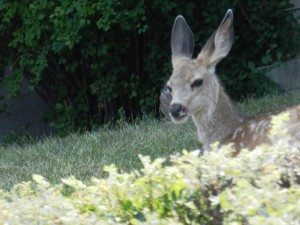 Linda Burton posting from Helena, Montana – “On your left you’ll see two deer in the yard,” said Brian, as our tour train rounded the corner two blocks from the capitol. I thought he was joking, pointing to a yard with fake deer for effect. But one of the deer moved its head. Everyone scrambled left, cameras clicking. It was deer, all right; two deer sitting by the hedge on the lawn of an ordinary yard in this downtown residential area. One a speckled fawn? Too cute! “Some people put flower guards out to protect their tulips from being eaten by the deer,” Brian continued, as we rounded yet another corner to stop before the governor’s home. Brian pointed out the designs in the glass door, and then around another corner we went, waving at the neighbors in their yards. It was a sunny morning, and the Last Chance Tour Train was packed; half of us tourists and half locals who wanted to show off their town in the sweetest way possible – on a tweetsie little train driven by a history teacher in an engineer’s hat, delivering interesting facts with a sometimes humorous twist. » read more
Linda Burton posting from Helena, Montana – “On your left you’ll see two deer in the yard,” said Brian, as our tour train rounded the corner two blocks from the capitol. I thought he was joking, pointing to a yard with fake deer for effect. But one of the deer moved its head. Everyone scrambled left, cameras clicking. It was deer, all right; two deer sitting by the hedge on the lawn of an ordinary yard in this downtown residential area. One a speckled fawn? Too cute! “Some people put flower guards out to protect their tulips from being eaten by the deer,” Brian continued, as we rounded yet another corner to stop before the governor’s home. Brian pointed out the designs in the glass door, and then around another corner we went, waving at the neighbors in their yards. It was a sunny morning, and the Last Chance Tour Train was packed; half of us tourists and half locals who wanted to show off their town in the sweetest way possible – on a tweetsie little train driven by a history teacher in an engineer’s hat, delivering interesting facts with a sometimes humorous twist. » read more
» posted on Tuesday, August 7th, 2012 by Linda Lou Burton
Going Wild
 Linda Burton posting from Helena, Montana – Montana is big. 94,109,542 acres big, to be precise. It is a state of riches, overflowing with nature’s generosity. And since the passage of the Wilderness Protection Act of 1964, signed into law by Lyndon Johnson, 3,443,038 acres of that land (about 3.7%) have become designated wilderness areas. Enthralled by the landscape around me, I’m getting information from the Montana Wilderness Association (MWA). Headquartered in Helena, the organization was founded in 1958 by Ken and Florence Baldwin; it was the nation’s first state organization concerned with wilderness preservation and the management of public lands. This nonprofit’s mission is
Linda Burton posting from Helena, Montana – Montana is big. 94,109,542 acres big, to be precise. It is a state of riches, overflowing with nature’s generosity. And since the passage of the Wilderness Protection Act of 1964, signed into law by Lyndon Johnson, 3,443,038 acres of that land (about 3.7%) have become designated wilderness areas. Enthralled by the landscape around me, I’m getting information from the Montana Wilderness Association (MWA). Headquartered in Helena, the organization was founded in 1958 by Ken and Florence Baldwin; it was the nation’s first state organization concerned with wilderness preservation and the management of public lands. This nonprofit’s mission is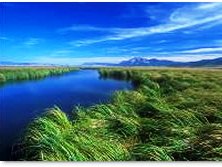 “to protect Montana’s wilderness heritage, quiet beauty and outdoor traditions, now and for future generations.” The ensuing years have seen coalitions and controversies, lawsuits and victories. In 1964 some of Montana’s best-known wilderness areas were designated – Bob Marshall, Cabinet Mountains, Gates of the Mountains, Selway-Bitterroot, and Anaconda-Pintler. By 1978 the Lincoln-Scapegoat, Great Bear, Rattlesnake, Absaroka-Beartooth, Mission Mountains, Welcome Creek, UL Bend, Medicine Lake, and Red Rock Lakes areas were added; more campaigns continue. » read more
“to protect Montana’s wilderness heritage, quiet beauty and outdoor traditions, now and for future generations.” The ensuing years have seen coalitions and controversies, lawsuits and victories. In 1964 some of Montana’s best-known wilderness areas were designated – Bob Marshall, Cabinet Mountains, Gates of the Mountains, Selway-Bitterroot, and Anaconda-Pintler. By 1978 the Lincoln-Scapegoat, Great Bear, Rattlesnake, Absaroka-Beartooth, Mission Mountains, Welcome Creek, UL Bend, Medicine Lake, and Red Rock Lakes areas were added; more campaigns continue. » read more
» posted on Monday, August 6th, 2012 by Linda Lou Burton
When The Bus Breaks
 Linda Burton posting from Helena, Montana – “Our bus broke down in Cheyenne,” she explained. “It was something about the compressor, and my husband drove to Denver to get the part. They didn’t have it either.” So Rory Block got to Helena by renting a car and driving 700 miles to sing for us tonight. “I kind of got into the groove for that Montana speed limit,” she confessed. Rory Block is sitting mid-stage in the Myrna Loy Center and I’m sitting 40 feet away in Seat #2, with a straight-line unobstructed view. She’d walked onstage precisely at 8 PM, a long, tall drink of water, in long legged slender slacks, long blond hair brushing the center of her back, some sparkly bracelets her only flash. This 5-time Blues Award Winner, heralded as “a living landmark,” “a national treasure” and “one of the greatest living acoustic blues artists” was here with us now, chatting to the house of 250 as though we were sharing our living room. The New York Times once declared of Rory “her playing is perfect, her singing otherworldly as she wrestles with ghosts, shadows and legends.” The evening took it one step more; she manages finicky sound systems and broken down buses with equal aplomb. » read more
Linda Burton posting from Helena, Montana – “Our bus broke down in Cheyenne,” she explained. “It was something about the compressor, and my husband drove to Denver to get the part. They didn’t have it either.” So Rory Block got to Helena by renting a car and driving 700 miles to sing for us tonight. “I kind of got into the groove for that Montana speed limit,” she confessed. Rory Block is sitting mid-stage in the Myrna Loy Center and I’m sitting 40 feet away in Seat #2, with a straight-line unobstructed view. She’d walked onstage precisely at 8 PM, a long, tall drink of water, in long legged slender slacks, long blond hair brushing the center of her back, some sparkly bracelets her only flash. This 5-time Blues Award Winner, heralded as “a living landmark,” “a national treasure” and “one of the greatest living acoustic blues artists” was here with us now, chatting to the house of 250 as though we were sharing our living room. The New York Times once declared of Rory “her playing is perfect, her singing otherworldly as she wrestles with ghosts, shadows and legends.” The evening took it one step more; she manages finicky sound systems and broken down buses with equal aplomb. » read more
» posted on Sunday, August 5th, 2012 by Linda Lou Burton
Signing In
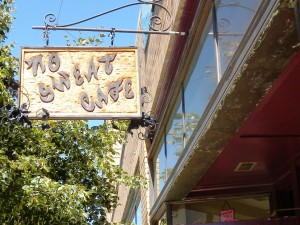 Linda Burton posting from Helena, Montana – “Please No Guns or Cell Phones Inside” states the sign at the door of the No Sweat Café on Last Chance Gulch, where another sign advertises the Two Dot Burger. I pushed through the screen door, glad to know I could expect a peaceful lunch. The nine tables and five booths inside were highly varnished knotty pine, served by pretty women in cute shorts and cowgirl boots. The Two Dot burger, by the way, is one patty bigger than the One Dot; most items on the menu leaned towards breakfast fare – omelets and pancakes and sausage, all done from scratch; I chose a sandwich, turkey and cream cheese, lettuce and tomato; with chips. The chips were blue corn and the tomato tasted as if it had just been picked from the tomato patch out back, it was that juicy fresh. I asked about their name; was told the original restaurant was near hot springs, therefore, people who came in were not (or were) sweating. Whatever, the cheeky humor and simply good food were a fun stop on a warm afternoon of exploring Helena. And being enticed by signs. » read more
Linda Burton posting from Helena, Montana – “Please No Guns or Cell Phones Inside” states the sign at the door of the No Sweat Café on Last Chance Gulch, where another sign advertises the Two Dot Burger. I pushed through the screen door, glad to know I could expect a peaceful lunch. The nine tables and five booths inside were highly varnished knotty pine, served by pretty women in cute shorts and cowgirl boots. The Two Dot burger, by the way, is one patty bigger than the One Dot; most items on the menu leaned towards breakfast fare – omelets and pancakes and sausage, all done from scratch; I chose a sandwich, turkey and cream cheese, lettuce and tomato; with chips. The chips were blue corn and the tomato tasted as if it had just been picked from the tomato patch out back, it was that juicy fresh. I asked about their name; was told the original restaurant was near hot springs, therefore, people who came in were not (or were) sweating. Whatever, the cheeky humor and simply good food were a fun stop on a warm afternoon of exploring Helena. And being enticed by signs. » read more

